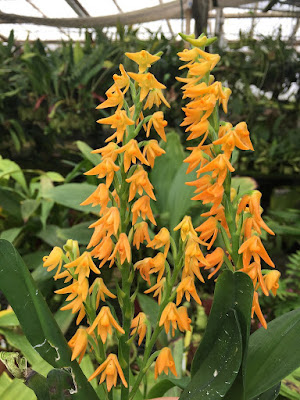Polystachya bella is found in Southwestern Kenya and Uganda. It grow on the mossy branches of tall trees in tropical riverine forest at 1800-1950 m. Although it is confined to a limited area in the wild, it is well established in cultivation.
Polystachya bella also called as The Beautiful Polystachya, is a species of the genus Polystachya. This species was described by Victor Samuel Summerhayes in 1960.
IDENTIFY POLYSTACHYA BELLA ORCHID PLANT
Polystachya bella is found in Southwestern Kenya and Uganda. It grow on the mossy branches of tall trees in tropical riverine forest at 1800-1950 m. Although it is confined to a limited area in the wild, it is well established in cultivation.
It is a medium sized, 15-30 cm tall, epiphytic, cool growing species with oval, compressed 2-5 cm long pseudobulbs tightly spaced on a branching rhizome that have 1 to 4, 5-16 cm long, 1.5-2.7 cm wide leaves that are coriaceous, but flexible, suberect, and narrowly elliptic.
The Beautiful Polystachya bloom mostly in winter from the up to 25 cm long, erect, pubescent, simple or branched, sub-densely many-flowered inflorescence. The flowers are suberect, yellow or gold.
POLYSTACHYA BELLA ORCHID PLANT CARE AND CULTURE
Cultural information should only be used as a guide, and should be to be adapted to suit you. Your physical location; where you grow your plants, how much time you have to devote to their care, and many other factors, will need to be taken into account. Only then can you decide on the cultural methods that best suit you and your plants.
Light:
Polystachya bella needs a light level of 18000-25000 lux. Light should be filtered or diffused, and plants should not be exposed to direct midday sun. Strong air movement should be provided at all times.
Temperature:
Throughout the year, the days temperature at average 21-26°C, and nights average 13-14°C, with a diurnal range of 7-12°C. The warmest temperatures and the greatest diurnal range of the year occur in winter.
Humidity:
The Beautiful Polystachya need the humidity of 70-80% in summer, dropping to 55-60% most during most of the remainder of the year.
Substrate, growing media and repotting:
Polystachya bella may be grown in relatively small pots or baskets filled with an open, fast-draining medium that retains some moisture after watering. The medium should become somewhat dry between waterings, however. The standard fir-bark mixes using medium-sized bark work well for many growers.
Plants may also be mounted tightly to a tree-fern slab. If mounted, however, high humidity must be maintained and the plants watered at least once daily in summer. Several waterings a day may be necessary for mounted plants during extremely hot, dry weather.
These orchids appear to grow better when allowed to form large clumps, so they should be divided as little as possible. Repotting, mounting, or dividing should be done only when new root growth is just starting. This allows the plant to become reestablished in the shortest possible time with the least amount of stress.
Watering:
Rainfall is moderate heavy from midspring to early autumn. Averages than fall into a 3 months drier period in winter. Cultivated plants should be watered heavily while actively growing, but drainage must be excellent, and the roots allowed to become dry between waterings.
Fertilizer:
1/4-1/2 recommended strength, applied weekly when plants are actively growing. You can use a balanced fertilizer throughout the year; but also can use a high-nitrogen fertilizer from spring to midsummer, then switch to one high in phosphates in late summer and autumn.
Rest period:
Growing conditions should be maintained all year. Water should be reduced for cultivated plants in winter, but they should not remain without water for long periods. Somewhat irregular early-morning mistings between occasional light waterings should provide sufficient moisture in most growing areas. Fertilizer should be reduced or eliminated until new growth starts and heavier watering is resumed in spring.















COMMENTS